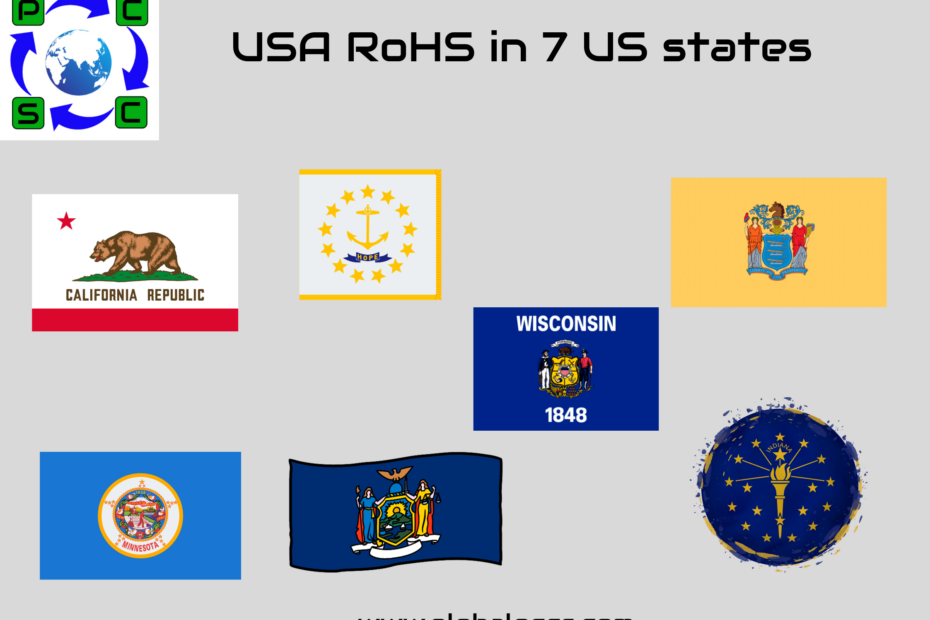
RoHS
The RoHS is an acronym that stands for Restriction Of Hazardous Substances and every RoHS regulation aims at restricting the use of hazardous substances contained in electrical and electronic equipment, to better protect the environment and human health. As a result, the waste of electrical and electronic equipment (WEEE) becomes easier to recycle and less harmful.
Substances under RoHS are
They are heavy metals (lead, mercury, cadmium, chromium hexavalent) and, depending on the jurisdictions, some additives in plastics, like PBBs, PBDEs, and phthalates (BBP, DBP, DEHP, and DIBP).
USA RoHS
USA RoHS regulations mimic EU RoHS per Directive 2002/95/EC, also called RoHS 1. However, unlike the European Union, US State regulations often merge the RoHS and WEEE / e-waste rules and the RoHS rules vary from one jurisdiction to another.
Although there isn’t a RoHS regulation at the federal level, various US States have passed RoHS bills applicable to electrical and electronic equipment (EEE). They are what we call USA RoHS.
USA RoHS in 7 US states.
California RoHS:- It is probably the most popular USA RoHS regulation. The gist is a product that meets EU RoHS 1 restrictions and will also comply with the California RoHS restrictions. Specifically, California RoHS restricts the presence of the four common RoHS heavy metals in EEE. The concentrations of these metals are the same as RoHS 1. The State of California required the Department of Toxic Substances Control (DTSC) to enact its own RoHS (Restriction of Hazardous Substances) laws:
● Health and Safety Code sections 25214.9-25214.10.2
● Regulation title 22, section 66260.202
Restricted substances under california RoHS are
● Lead, 0.1% by weight
● Mercury, 0.1% by weight
● Cadmium, 0.01% by weight
● Hexavalent chromium, 0.1% by weight
Electronic Devices covered under California RoHS are
1. Devices containing Cathode Ray Tubes (CRT devices)
2. CRTs
3. Computer monitors that have CRTs
4. Laptops with Liquid Crystal Display (LCD)
5. Desktop monitors with LCD
6. Televisions with CRTs
7. Televisions with LCD
8. Plasma televisions
9. Portable DVD players with LCD
When a new device is added to the DTSC’s list, its restriction is not immediate. The device only becomes regulated starting July 1st of the following year. Therefore, California’s RoHS only applies to covered devices manufactured after the date it became official (i.e., July 1st).
Products Excluded from California RoHS
● A video display incorporated into a motor vehicle, including any part assembled for or by a vehicle manufacturer (or franchiser). Replacement parts are also exempt.
● A video display incorporated in industrial, commercial, or medical; monitoring or control devices.
● A video display incorporated in a washing machine; dryer; refrigerator and related equipment; microwave; oven; dishwasher; and portable air conditioning, dehumidifying, or purifying equipment.
● Any device on or after the date ceases to be covered by the regulations.
Indiana RoHS:-
Manufacturers of household video displays are required to disclose whether any of the first six EU RoHS 1 compounds are found in their products over the levels under Indiana Code 13-20.5, Article 20.5 Electronic Waste. It is important to remember that products covered by RoHS exemptions need to be listed on the Indiana annually RoHS report.
Minnesota RoHS:-
Similar to Indiana RoHS, Minnesota RoHS mandates that producers of home video displays report any marketed products that include chemicals above the general EU RoHS 1 thresholds. Importantly, producers must take into account RoHS exemptions, similar to Indiana RoHS. According to Chapter 115A Waste Management Section 1312 Registration program, this requirement is applicable.
New Jersey RoHS:-
Similar to California RoHS, New Jersey RoHS has substance limits and requires a yearly report. According to the Electronic Waste Management Act, 13:1E-99.101 Compliance with Directive 2002/94/EC, in-scope electronic equipment must adhere to the homogeneous material level heavy metals content restrictions of EU RoHS 1. A desktop or personal computer, computer monitor, portable computer, desktop printer, desktop fax machine, or television sold to a customer are also included in the act definition of a covered electronic device. Additionally applicable are reporting and e-waste duties, as well as the transmission of test reports.
New York RoHS:-
RoHS is applicable to televisions, certain small gadgets, and computers and their peripherals under the New York State Electronic Equipment Recycling and Reuse Act. However, New York RoHS does not take into account producers who place fewer than 1,000 protected electronics each year. In-scope manufacturers are required by 27-2605 to declare whether their goods specifications for Eu RoHS 1 chemicals are met every year. Additionally, they must disseminate data regarding e-waste.
Rhode Island RoHS:-
Rhode Island RoHS and New York RoHS are comparable. Computers, televisions, other screens larger than 9 inches diagonally, and printers are all examples of in-scope products, according to Chapter 24.10 of the Electronic Waste Prevention, Reuse, and Recycling Act. However, there are a few items that fall outside of that area, such automobile screens. Manufacturer duty mandates that they adhere to EU RoHS 1 on the six compounds ( 23-24.10-9).
Wisconsin RoHS:-
Wisconsin also has a RoHS-like law. Wisconsin RoHS is unique because it targets EU RoHS 1 or a successor directive. Therefore, EU RoHS 2 directive 2011/65/EU applies. Manufacturers must report annually whether in-scope devices comply with the ten RoHS-restricted substances, with any applicable exemptions. Covered devices under the Wisconsin Statute Chapter 287.17 – Electronic Waste Recycling include :
● Consumer computers,
● Consumer printers,
● Consumer video displays of at least 7 inches in its longest diagonal,
Importantly, the term consumer here includes both household and school uses.
Main differences between 7 States of USA RoHS regulations:-










 Authorised IMDS & CDX Training & Consulting partner for
Authorised IMDS & CDX Training & Consulting partner for






